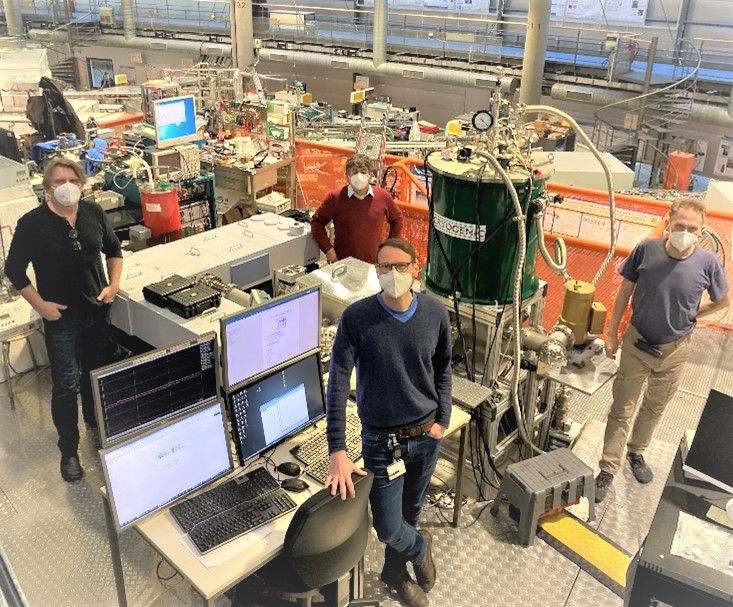New 12 T magnet on BESSY II’s experimental floor strengthens energy and magnetism research

Exhausted but happy: f.l.t.r. - K. Holldack (HZB), A. Schnegg (MPI CEC Mülheim, HZB), T. Lohmiller (HZB, HUB), D. Ponwitz (HZB) after the successful commissioning of the new 12T magnet (green).
Electron paramagnetic resonance (THz-EPR) at BESSY II provides important information on the electronic structure of novel magnetic materials and catalysts. In mid-January 2022, the researchers brought a new, superconducting 12-T magnet into operation at this end station, which promises new scientific insights.
At the THz-EPR end station, unique experimental conditions are provided through a combination of coherent THz-light from BESSY II and high magnetic fields. These capabilities have now been extended by a new superconducting 12 T magnet, acquired through funding from the BMBF network project “ERP-on-a-Chip” and HZB.
“The extended capabilities of the new setup will allow exciting new science with user groups and within our joint lab EPR4Energy operated together with Max Planck Institute for Chemical Energy Conversion, Mühlheim. We are very pleased about the successful commissioning of the superconducting magnet, which currently delivers the highest magnetic field at BESSY II”, says Karsten Holldack, the responsible beamline scientist.
(red)
https://www.helmholtz-berlin.de/pubbin/news_seite?nid=23346;sprache=en
- Copy link
-
Research up close! The Long Night of Science at HZB
On 28 June, it's that time again: the Long Night of Science will take place from 5 pm to midnight in Berlin and also in Adlershof! Come around and take a look behind the scenes of our exciting research.
-
HZB and National University Kyiv-Mohyla Academy start cooperation in Energy and Climate
Helmholtz-Zentrum Berlin für Materialien und Energie GmbH (HZB) and the National University of "Kyiv-Mohyla Academy" (NaUKMA) have signed a Memorandum of Understanding (MoU). The MoU serves as the starting point for collaborative research, academic exchange, and capacity-building between the two institutions. Actions will be taken to establish the Joint Research and Policy Laboratory at NaUKMA in Kyiv. The aim of the future laboratory is to jointly develop research and policy analysis, focusing on the energy and climate dimensions of Ukraine’s EU integration.
-
MAX IV and BESSY II initiate new collaboration to advance materials science
Swedish national synchrotron laboratory MAX IV and Helmholtz-Zentrum Berlin (HZB) with BESSY II light source jointly announce the signing of a 5-year Cooperation Agreement. The new agreement establishes a framework to strengthen cooperation for operational and technological development in the highlighted fields of accelerator research and development, beamlines and optics, endstations and sample environments as well as digitalisation and data science.
